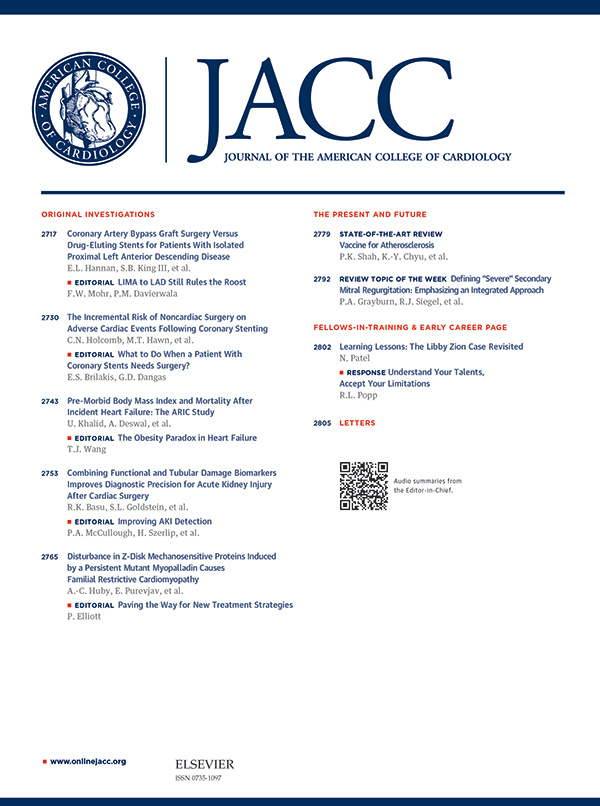低危主动脉瓣狭窄患者经导管或手术主动脉瓣置换术后的5年预后
IF 21.7
1区 医学
Q1 CARDIAC & CARDIOVASCULAR SYSTEMS
引用次数: 0
摘要
Evolut低风险试验表明,经导管主动脉瓣置换术(TAVR)在2年全因死亡率或致残性卒中的主要终点方面不逊于手术。5年的结果未见报道。目的:本研究旨在评估Evolut低风险试验中TAVR与手术患者的5年临床和血流动力学结果。方法将低危重度主动脉瓣狭窄患者随机分为TAVR组和手术组。主要终点是全因死亡率或致残性中风的综合指标。次要终点包括临床、超声心动图和5年的生活质量。结果共1414例患者尝试种植(n = 730 TAVR, n = 684例手术)。平均年龄为74岁(51-88岁),女性占35%。在5年时,Kaplan-Meier估计TAVR组全因死亡率或致残性卒中的主要终点为15.5%,手术组为16.4% (P = 0.47)。Kaplan-Meier估计TAVR组和手术组的全因死亡率分别为13.5%和14.9% (P = 0.39),致残性卒中的死亡率分别为3.6%和4.0% (P = 0.57)。TAVR组心血管死亡率为7.2%,手术组为9.3% (P = 0.15)。TAVR组非心血管死亡率为6.8%,手术组为6.2% (P = 0.73)。对失去随访或退出研究的患者进行部位级生命状态扫描。加上这些患者,TAVR患者的5年全因死亡率为14.7%,手术患者为15.2% (P = 0.74)。5年内,TAVR的再介入率为3.3%,手术为2.5% (P = 0.44)。两组患者的生活质量均有持续改善,堪萨斯城心肌病调查问卷的TAVR平均得分为88.3±15.8,手术平均得分为88.5±15.8。结论:5年内,严重主动脉瓣狭窄患者接受TAVR或手术治疗的全因死亡率或致残性卒中发生率相当。阀门的耐用性和性能在两个臂都是优秀的。这项中期评估强化了TAVR在低手术风险的严重主动脉狭窄患者中优于手术的地位(美敦力Evolut经导管主动脉瓣置换术在低风险患者;NCT02701283)本文章由计算机程序翻译,如有差异,请以英文原文为准。

5-Year Outcomes After Transcatheter or Surgical Aortic Valve Replacement in Low-Risk Patients With Aortic Stenosis
Background
The Evolut Low Risk trial demonstrated that transcatheter aortic valve replacement (TAVR) was noninferior to surgery for the primary endpoint of all-cause mortality or disabling stroke at 2 years. Outcomes at 5 years have not been reported.
Objectives
This study sought to evaluate 5-year clinical and hemodynamic outcomes with TAVR vs surgery in patients from the Evolut Low Risk trial.
Methods
We randomly assigned low-risk patients with severe aortic stenosis to TAVR or surgery. The primary endpoint was a composite of all-cause mortality or disabling stroke. Secondary endpoints included clinical, echocardiographic, and quality-of-life outcomes through 5 years.
Results
A total of 1,414 patients underwent an attempted implant (n = 730 TAVR, n = 684 surgery). The mean age was 74 years (range 51-88 years), and women accounted for 35% of patients. At 5 years the Kaplan-Meier estimate for the primary endpoint of all-cause mortality or disabling stroke was 15.5% for the TAVR group and 16.4% for the surgery group (P = 0.47). The Kaplan-Meier estimates in the TAVR and surgery groups for all-cause mortality were 13.5% and 14.9% (P = 0.39) and for disabling stroke were 3.6% and 4.0% (P = 0.57). Cardiovascular mortality was 7.2% in the TAVR group and 9.3% in the surgery group (P = 0.15). Noncardiovascular mortality in the TAVR group was 6.8% and 6.2% in the surgery group (P = 0.73). A site-level vital status sweep was performed for patients who were lost to follow-up or withdrew from the study. With the addition of these patients, the all-cause mortality rate at 5 years for patients undergoing TAVR was 14.7% and for surgery was 15.2% (P = 0.74). Over 5 years, valve reintervention rate was 3.3% for TAVR and 2.5% for surgery (P = 0.44). A sustained improvement in quality of life was observed in both treatment arms with mean Kansas City Cardiomyopathy Questionnaire summary score of 88.3 ± 15.8 in TAVR and 88.5 ± 15.8 in surgery.
Conclusions
At 5 years, patients with severe aortic stenosis who were treated with either TAVR or surgery had comparable rates of all-cause mortality or disabling stroke. Valve durability and performance were excellent in both arms. This midterm evaluation reinforces the position of TAVR as noninferior to surgery in patients with severe aortic stenosis at low surgical risk (Medtronic Evolut Transcatheter Aortic Valve Replacement in Low Risk Patients; NCT02701283)
求助全文
通过发布文献求助,成功后即可免费获取论文全文。
去求助
来源期刊
CiteScore
42.70
自引率
3.30%
发文量
5097
审稿时长
2-4 weeks
期刊介绍:
The Journal of the American College of Cardiology (JACC) publishes peer-reviewed articles highlighting all aspects of cardiovascular disease, including original clinical studies, experimental investigations with clear clinical relevance, state-of-the-art papers and viewpoints.
Content Profile:
-Original Investigations
-JACC State-of-the-Art Reviews
-JACC Review Topics of the Week
-Guidelines & Clinical Documents
-JACC Guideline Comparisons
-JACC Scientific Expert Panels
-Cardiovascular Medicine & Society
-Editorial Comments (accompanying every Original Investigation)
-Research Letters
-Fellows-in-Training/Early Career Professional Pages
-Editor’s Pages from the Editor-in-Chief or other invited thought leaders

 求助内容:
求助内容: 应助结果提醒方式:
应助结果提醒方式:


